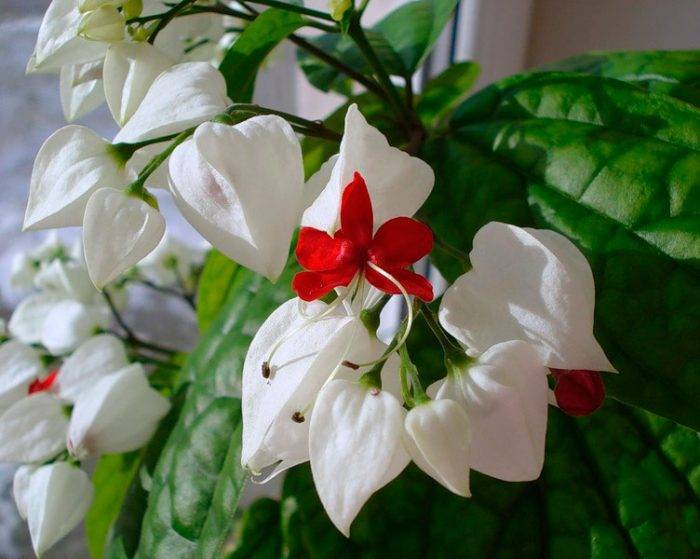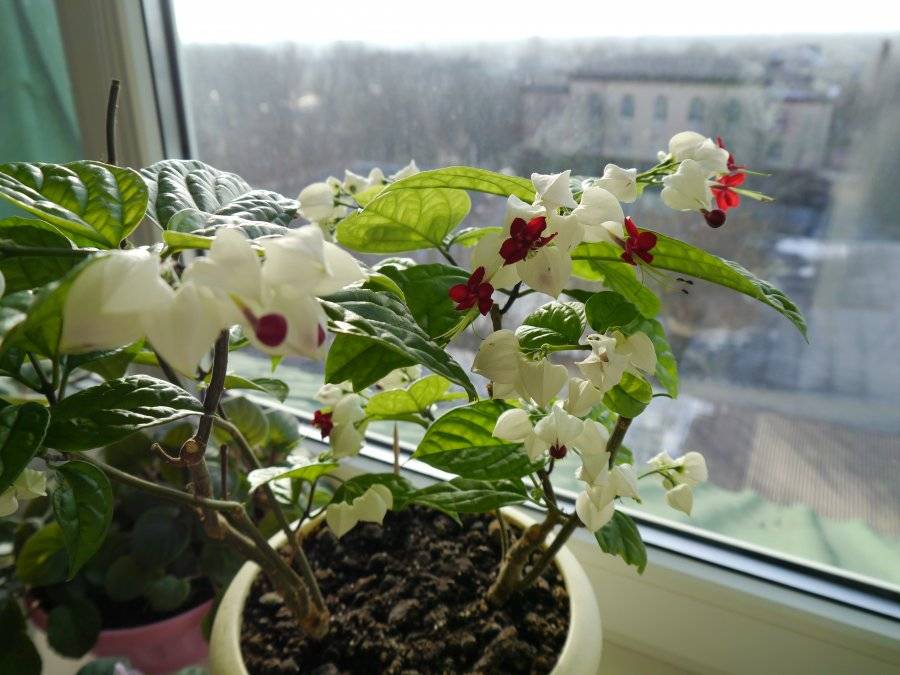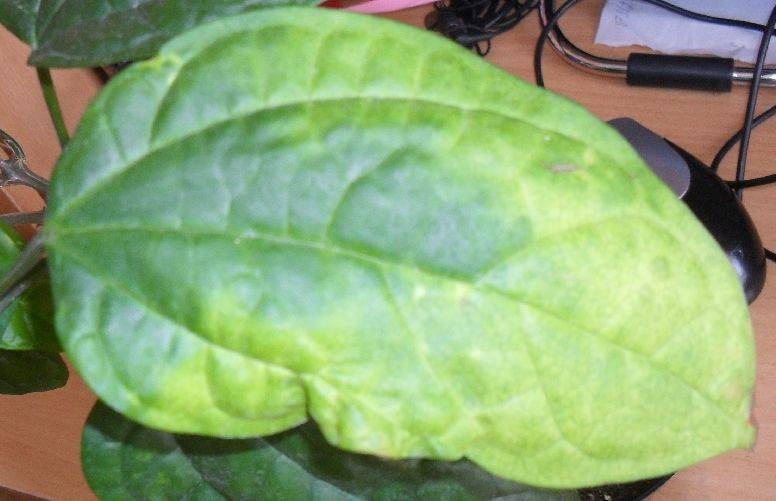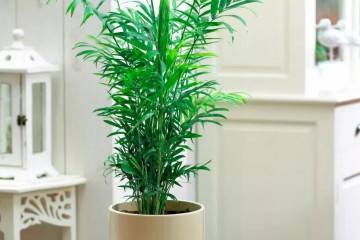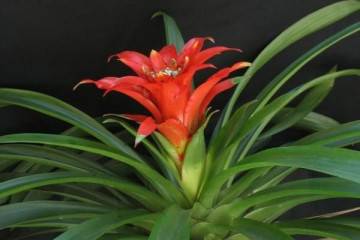Clerodendrum - home and outdoor care
Content:
The clerodendrum plant is a beautiful and popular shrub that can grow at home. The article will describe the history of the plant, recommendations for growing and tips for solving common problems.
Botanical description and history of origin
The Clerodendrum flower is a perennial, flowering, shrub or tree-like representative of the flora, which belongs to the Verbenaceae family of the order Clear-flowered. This species originated in the tropics of South America, Asia and West Africa. In the wild, the plant reaches 4 m.
Despite the fact that the plant is a shrub, sometimes it looks more like vines and trees, and the flowers look like butterflies or small bouquets. The flowers and leaves of the plant smell good. The shrub is often planted in garden plots, but it can grow at home, if properly looked after. The plant is hardy and unpretentious to care for. Flowering occurs throughout the summer.
The soft, liana-shaped stem can reach a length of 2.5 to 5 m if left untrimmed. The bright green leaves are oval or heart-shaped, the petioles are long, the surface is uneven, they are located opposite on the stem. Many types of clerodendrum differ in color, aroma, shape and size.
Clerodendrum: home careconditions
In the apartment, it is recommended to place the clerodendrum tree of fate on a window facing the east or west side, so that the plant regularly receives sunlight, but does not burn from direct sunlight. You should not put a flower on the northern windows, since it will not bloom.
Temperature
The plant needs an optimum air temperature of 18-25 ° C. In winter, the required temperature is slightly lower - from 13 ° C to 15 ° C.
Lighting
The shrub needs sun, but its direct rays will burn the foliage and harm the plant. Shading should be done from midday rays.
Watering
Watering should be done abundantly using soft water. Do not water the plant again until the top layer of soil in the pot dries out. In winter and autumn, when the clerodendrum is at rest, the amount of watering depends on how hot or cold it is in the room. In cold temperatures, less watering is required. But it is impossible to allow the soil to completely dry out, as well as its excessive moisture.
Humidity
The shrub needs humid (at least 60%) air. The required humidity is achieved by using a spray bottle. If the air is too dry, leaves may fall off.
Spraying
In the hot season, the plant should be sprayed daily 1-2 times (in cloudy weather, a little less often), during the rest period - no more than once every 2-3 days.
Priming
For a plant grown at home, you should choose a loose, high-quality, fertile soil mixture. The acidity level should be moderate. Ready-made formulations with the required characteristics are sold in special stores. But you can make such a mixture yourself: you need to mix peat, sand and leafy earth (or humus), then add moss, perlite or vermiculite to improve water and air access.
Top dressing
In spring and summer, the shrub must be fed every 7-10 days. Top dressing should be mixed into the water for irrigation (the proportions are indicated in the fertilizer instructions).
Support
Clerodendrum does not need a support, although it does affect the appearance of the plant. In order for the plant to grow in the shape of a long liana, a thin twine or wire must be used. So that the shrub does not grow in height and has a more compact shape, it is better to make it a support in the form of a ring.
Transfer
It is best to transplant the shrub in early spring, before flowering. At this time, the plant is just beginning to wake up. Young bushes before reaching the age of five should be replanted every year, while choosing a pot 3 cm wider than the previous one. After the age of five, it is enough to replant the shrub every 3-5 years.
After buying a new plant in the store, you should transplant into another pot no earlier than two weeks later. A transplant from a store pot is needed because it contains a universal soil mixture for all indoor plants, and not a special one for clerodendrum.
The new pot should have drainage holes. First, a drainage layer of 4 cm should be poured onto the bottom, and then the soil. A mixture with the characteristics necessary for clerodendrum is sold in specialized stores. To prepare the soil mixture yourself, and not use a purchased one, it should be borne in mind that it must have a weak acidity. In addition, it should consist of humus (or leafy soil, but in this case it should be taken 2 times more), dry peat, coarse sand and other additives that affect air and water permeability and acidity (moss, perlite, vermiculite, etc.). etc.).
When transplanting, you need to carefully handle the roots of the plant, avoiding damage. Do not shake off the soil or lower it under a stream of water under pressure. The root with a lump of earth is placed in a new pot, then new soil is poured on the sides and everything is compacted.
Pruning
With proper care, the plant reaches 4-5 m. It is necessary to cut the plant in late winter - early summer. The pruning procedure is useful for stimulating the branching and flowering of the shrub. Old stems harden, young ones can be shaped.
The stems, due to which the bush becomes unnecessarily thick, are removed. Cutting the stems is carried out by 1/3, this will not cause serious harm to the shrub.
How does it multiply
The flower propagates in two ways.
Seeds
To propagate the plant, you can use seeds taken from another home flower of the clerodendrum or, if it is not available, buy it from a specialized store. The breeding procedure is complex and can be a hassle, and the resulting plant does not retain its species characteristics.
Seeds must be sown in a micro greenhouse in late winter - early spring. The first step is to fill the container with a mixture of turf, river sand and peat, then sow the seeds evenly over the surface of the earth.
With proper care of the crops (timely watering and regular airing), the first shoots will appear in 1.5-2 months. After the formation of four full-fledged sheets, they should be seated in cups 6 cm in diameter. You can plant up to three sprouts in 11 cm pots.
Cuttings
When breeding clerodendrum with cuttings, it should be remembered that hardened and lignified shoots will germinate faster than green ones. The cuttings should be placed in water or moist soil, providing room temperature and good lighting. To prevent the twigs from drying out, they are covered with polyethylene. As soon as roots appear and new leaves grow, the plant can be replanted.
Dormant period
Most of the clerodendrum species need a rest period. The plant needs to rest to start blooming next year. As soon as the flowering period ends, you need to stop feeding the plant and reduce the frequency of watering. After the lower foliage has fallen off, it is worth moving the shrub to a room with a temperature of 13-18 ° C.
Possible problems
In growing a flower, many are faced with problems that can be solved.
Clerodendrum does not bloom
The reason why Clerodendrum does not bloom is often very commonplace. It is difficult to get a plant to bloom if it is not properly cared for during dormancy. After flowering, you need to remove the clerodendrum in a cool place and gradually reduce the frequency of watering, but do not allow the soil to completely dry out. The rest period lasts from 1.5 to 2 months. As soon as it is over, the shrub will begin to give new shoots. In this case, you need to resume the previous watering frequency, if necessary, prune.
Clerodendrum turns yellow
The growing season of the shrub can sometimes be accompanied by yellowing of the leaves. Usually they begin to brighten due to insufficient soil moisture. To fix the problem, it is necessary to water the indoor Clerodendrum flower more often.
Chlorosis can be another cause of yellowness. To treat it, you need to treat the plant with an iron-containing agent.
Pests
The most dangerous insects for clerodendrum are spider mites and whiteflies. To get rid of the shrub from these pests, it is worth treating it with an insecticidal agent.
One of the problems that manifests itself when breeding clerodendrum is chlorosis - dark specks on foliage that appear from exposure to open sunlight. For the prevention of chlorosis, it is worth treating it in cold seasons with an iron-containing agent.
Common varieties
The following varieties are in great demand among florists.
- The fairest, or Javanese. An evergreen shrub with stems that have four edges. Reaches 3 m in height. Blooms for about four months - from early June to late September.
- Fragrant. Another name is Filipino Clerodendrum. Home care for him is carried out in the same way as for other varieties. It is a low variety, reaching 1-2 m. The flowers are large, up to 8 cm in diameter.
- Wallich's Clerodendrum. An ornamental type of shrub. Grown in pots. It has large three-centimeter flowers with five petals.
- Clerodendrum Prospero (Prospero nodding, Wallichi nodding jasmine). The shrub has bright green petals and faded green calyces with white flowers. It looks like a miniature tree.
- Clerodendrum Bunge is a plant with dark green rough leaves. The flowers are small, pink in color.
- Prickleless, or Inerme. Reaches 3 m in height. The flower has shiny leaves, white flowers with pink stamens.
There are many more varieties of flower such as Clerodendrum Splendens, Clerodendrum Schmidtii, Clerodendrum Paniculatum, etc.
Clerodendrum, which is easy and simple to care for, can be grown both in the summer cottage and at home. By following the recommendations outlined in the article, you can avoid most of the problems that beginners face when breeding this plant.
